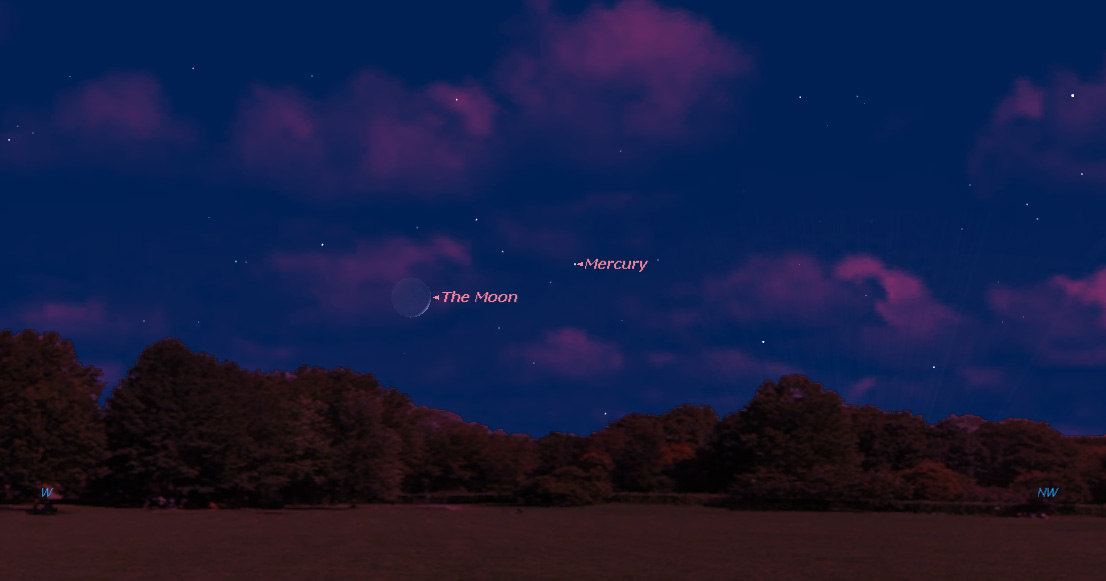
It has been a great couple of weeks for those who have sought out the so-called "elusive planet" Mercury. This speedy, rocky little world has been readily visible, appearing as a bright "star" low in the west-northwest sky about an hour after sunset and tonight the moon joins the show.
To spot Mercury tonight (May 30), wait until about an hour after sunset and look low toward the west-northwest horizon. You should see the crescent moon just 5-percent illuminated and two days past new phase.
Weather permitting, Mercury should be visible about 6 degrees to the moon's right. Your closed fist held out at arm's length covers about 10 degrees of the night sky. Mercury should be visible to the unaided eye, but if you have binoculars, try scanning for it by scanning along the horizon. [Amazing Night Sky Photos for May 2014]
On Sunday (May 25), Mercury arrived at its greatest eastern elongation — it's greatest angular distance to the east of the sun in the sky — measuring a respectable 23 degrees. Your clenched fist held at arm’s length measures roughly 10 degrees, so Mercury was positioned more than two fists from the sun and visible against a relatively dark late-twilight sky.
Mercury has since started approaching the sun and has begun to slowly lower in the west-northwest sky at dusk. In addition, Mercury is also beginning to fade noticeably; a telescope reveals it as a crescent phase and that crescent is gradually narrowing.
Consequently, the innermost planet is undergoing a progressive fade-down. In fact, Mercury will dim from magnitude 0 on May 21 to magnitude +1.2 on June 1 — that's a three-fold drop in brightness.
In all likelihood, Mercury will become too low and too faint to be visible against the bright twilight glow by around June 3, but if you haven't yet had a glimpse of it, there is still some time left and on Friday evening, you'll have a nice benchmark to help you locate it in the form of a slender crescent moon.
Get the Space.com Newsletter
Breaking space news, the latest updates on rocket launches, skywatching events and more!
The very next night (Saturday), the moon will have lifted up and away from Mercury. Appearing slightly wider and easier to see, you’ll find it hovering about six degrees below the “king” of the planets, Jupiter. So within a time span of 24 hours, the moon will visit first with the smallest planet, Mercury, on Friday evening, followed the next evening by a visit with the largest of the planets, Jupiter.
Editor's note: If you have an amazing night sky photo you'd like to share for a possible story or image gallery, please contact managing editor Tariq Malik at spacephotos@space.com.
Joe Rao serves as an instructor and guest lecturer at New York's Hayden Planetarium. He writes about astronomy for Natural History magazine, the Farmer's Almanac and other publications, and he is also an on-camera meteorologist for News 12 Westchester, N.Y. Follow us @Spacedotcom. We're also on Facebook and Google+. Original article on Space.com.
Join our Space Forums to keep talking space on the latest missions, night sky and more! And if you have a news tip, correction or comment, let us know at: community@space.com.

Joe Rao is Space.com's skywatching columnist, as well as a veteran meteorologist and eclipse chaser who also serves as an instructor and guest lecturer at New York's Hayden Planetarium. He writes about astronomy for Natural History magazine, Sky & Telescope and other publications. Joe is an 8-time Emmy-nominated meteorologist who served the Putnam Valley region of New York for over 21 years. You can find him on Twitter and YouTube tracking lunar and solar eclipses, meteor showers and more. To find out Joe's latest project, visit him on Twitter.









